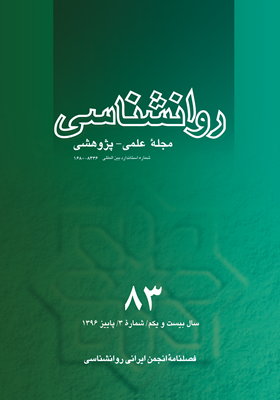مدل علّی برای ابعاد طرح ارتباطی خانواده، تاب آوری و مهارت مهار خشم با گرایش به خشونت
محورهای موضوعی :
1 - بخش روانشناسی دانشگاه مازندران، بابلسر
2 - بخش روانشناسی دانشگاه مازندران، بابلسر
کلید واژه: طرح های ارتباطی خانواده, تاب آوری, مهارت مهار خشم, گرایش به خشونت, دانش آموزان,
چکیده مقاله :
پژوهش حاضر باهدف تبیین رابطه علّی بین ابعاد الگوی ارتباطی خانواده، تاب آوری و مهار خشم با گرایش به خشونت در نوجوانان صورت گرفت.شرکت کنندگان این پژوهش، 287 از دانش آموزان دبیرستان های شهر بابلسر بودند که بر اساس روش نمونه گیری تصادفی خوشه ای چندمرحلهای انتخاب شدند. بهمنظور اندازه گیری متغیرهای پژوهش، ابزار های طرح های ارتباطی خانواده، تاب آوری، مهار خشم و گرایش به خشونت مورداستفاده قرار گرفتند. برای ارزیابی مدل پیشنهادی، از نرم افزار آموس و از روش تحلیل مسیر استفاده گردید که با توجه به مقادیر شاخص های بهدستآمده، داده ها با مدل تحقیق برازش داشت. بررسی اثرات کل نشان داد که جهتگیری گفتوشنود بیشترین تأثیر بر تغییرات گرایش به خشونت داشته است. محاسبة میزان تأثیر متغیرهای مستقل بر وابسته، حاکی از آن بود که 12 درصد از تغییرات، متغیر تاب آوری و 40 درصد از تغییرات، متغیر مهارت مهار خشم و 39 درصد از تغییرات، گرایش به خشونت، توسط مدل تبیین می شود. بررسی نقش واسطه ای تاب آوری و مهارت مهار خشم در رابطه بین طرح -های ارتباطی خانواده و گرایش به خشونت نشان داد که تاب آوری در رابطه بین جهتگیری گفتوشنود و گرایش به خشونت و مهارت مهار خشم در رابطه بین هر دو بعد جهتگیری با گرایش به خشونت نقش واسطه ای ایفا می کنند.
The aim of this study was to investigate the mediating role of resilience and control of anger in relationship between family communication patterns dimensions and tendency to violence in high school students. Therefore 287 high school students of Babolsar city were selected by random multi-stage cluster sampling method. To collect data, Family Communication Patterns, Resilience,Scale Control of Anger Questionnaire and Tendency to Violence Scale were used. In order to evaluate the proposed model of this study, path analyze method was used. Regarding the values obtained for the indexes, data were fitted with the proposed model of the research. The general effect showed that the conversation orientation variable has the most effectiveness on the changes of tendency to violence. Calculation of the affectivity degree of independent variables on dependent ones indicates that 12 percent of the changes in resilience variable, 40 percent of changes in control of anger, and 39 percent of changes in tendency to violence variable are explained by the proposed model. Investigating the mediating role of resilience and control of anger in the relationship of family communication pattern and tendency to violence found that resilience have a mediating role in the relationship of conversation dimension of family communication pattern and tendency to violence and control of anger have a mediating role in the relationships of both dimensions of family communication pattern and tendency
